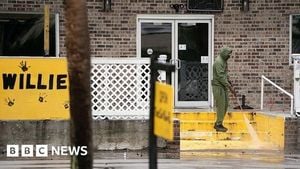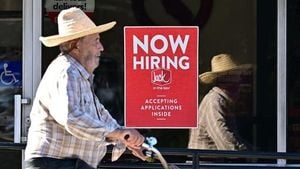Missouri is stepping into the national spotlight as the latest battleground in a fierce, fast-moving fight over congressional redistricting, a contest that’s pitting Republicans and Democrats against each other in a bid to reshape the political map ahead of the 2026 midterm elections. The move, announced by Republican Governor Mike Kehoe on August 30, 2025, signals Missouri’s entry as the third state—following Texas and California—to pursue mid-decade redistricting for clear partisan advantage.
Governor Kehoe declared he would call a special legislative session beginning September 3, 2025, with a twofold agenda: redrawing Missouri’s U.S. House districts to favor the GOP and advancing a constitutional amendment that would make it more difficult for citizens to pass ballot measures. The governor’s proposed map specifically targets Democratic Representative Emanuel Cleaver’s Kansas City-area district, stretching it eastward into rural, Republican-leaning areas. Kehoe made no secret of his intentions, stating, “Missouri’s conservative, common-sense values should be truly represented at all levels of government.” According to the Associated Press, this move is part of a coordinated nationwide effort, with former President Donald Trump urging Republican-led states to redraw district lines and fortify the party’s hold on the House.
The timing of Kehoe’s announcement was hardly coincidental. Just hours earlier, Texas Governor Greg Abbott had signed into law a new congressional voting map, designed to help Republicans gain five more seats in the 2026 midterms. Abbott celebrated the move, declaring in a video shared on X, “Texas is now more red in the United States Congress.” The Texas strategy is clear: lock in a Republican advantage by redrawing lines to maximize GOP representation. But Democrats aren’t sitting idly by. In California, Democratic Governor Gavin Newsom is pushing a competing plan, asking voters to approve a new map aimed at giving his party a five-seat boost in the House. Newsom, who’s emerged as a vocal adversary of Trump on redistricting and other issues, didn’t mince words online, mocking Abbott as the president’s “#1 lapdog.”
The national chess match doesn’t end there. As the Associated Press reports, other states—both Republican and Democratic—are jumping into the fray. Florida, Indiana, Illinois, Maryland, New York, and Utah are all either considering or actively pursuing changes to their congressional maps. In Utah, a judge recently ordered the Republican-led legislature to redraw districts after ruling lawmakers had weakened and ignored an independent commission created to prevent partisan gerrymandering. Under the previous map, Republicans had swept all four of Utah’s congressional seats.
Missouri’s current political makeup in the U.S. House is six Republicans to two Democrats—Cleaver and Wesley Bell of St. Louis. The new map could tip the scales even further. Democrats, however, are sounding the alarm. Missouri state House Minority Leader Ashley Aune did not hold back, calling Kehoe a “Trump puppet” and accusing him of trying to “steal a congressional seat for Republicans” and gut the ballot initiative process. She warned, “It marks the worst threat to the integrity of our state government since pro-slavery lawmakers voted for Missouri to join the Confederacy in 1861.” Representative Cleaver, whose seat is directly targeted by the new map, called the redistricting effort “an attack on democracy perpetrated by Trump,” adding, “This attempt to gerrymander Missouri will not simply change district lines, it will silence voices. It will deny representation.” Cleaver has vowed not to concede the seat without a fight.
Democrats in Missouri, though, face an uphill battle. Unlike in Texas, where Democrats once delayed a vote by leaving the state, Missouri’s legislative rules mean their absence won’t prevent a quorum. Even a filibuster in the state Senate could be shut down by Republican procedural maneuvers—a tactic already used earlier in 2025 to pass a constitutional amendment restricting abortion. With the GOP holding a supermajority, Democrats’ ability to block the new map is limited at best.
The stakes are high. After the 2024 elections, Republicans hold a razor-thin 220-215 majority in the U.S. House. Democrats need just three seats to retake control in 2026. According to an analysis by the Associated Press, the 2024 outcome closely mirrored the national popular vote, but both parties benefited from districting advantages in particular states. The incumbent president’s party often loses seats in midterms—Trump himself experienced this in 2018, when Democrats won the House and launched investigations into his administration. Determined to avoid a repeat, Trump is now actively urging Republican-led states to shore up their congressional seats through redistricting.
California’s response to Texas’s aggressive redistricting has been swift and controversial. On August 21, 2025, the Democratic supermajorities in the California Senate and Assembly approved the Election Rigging Response Act, placing Proposition 50 on the November 4, 2025, ballot. If passed, it would amend the state constitution, undo significant parts of the work done by the California Citizens Redistricting Commission, and adopt a new map designed to add five Democratic seats in the U.S. House. Governor Newsom signed the legislation immediately, and his message was clear: “Keep em coming, @GOP. We’ll keep winning.”
Republicans in California, however, aren’t giving up. On August 27, the state Supreme Court rejected an emergency GOP petition to remove the redistricting measure from the ballot. The petition, filed by the Dhillon Law Group and several Republican legislators, argued that the state constitution requires redistricting by an independent citizens commission, not lawmakers, and accused Democrats of rushing the legislation through in just four days without proper public notice—a violation of constitutional procedure. “Allowing this unconstitutional measure onto the ballot would impose needless costs and uncertainty on both election officials and the public,” the petitioners argued. Despite the setback, Assembly Minority Leader James Gallagher and other Republicans have floated a dramatic countermeasure: a bill to create a new state out of 35 mainly inland counties. But this proposal faces steep odds, requiring Democratic support in both houses and eventual Congressional approval.
Meanwhile, legal challenges are mounting across the country. In Texas, voting rights groups have filed lawsuits claiming the new map weakens the electoral influence of Black voters. Texas Democrats have also pledged to fight the map in court. The Associated Press notes that after the 2020 census, some Missouri Republicans pushed for a map that would give them a 7-1 advantage, but the GOP majority ultimately opted for a less aggressive plan, fearing legal challenges and the risk of creating competitive districts that could swing Democratic in a bad year for Republicans.
As the redistricting wars heat up, the consequences for American democracy are profound. With partisan lines hardening and both sides deploying every tool at their disposal, the shape of congressional representation in 2026—and perhaps the balance of power in Washington—hangs in the balance. The special session in Missouri may be just the latest front, but it’s unlikely to be the last.
With the future of congressional control and the integrity of the democratic process at stake, all eyes are on the statehouses—and, soon, the courts and the ballot box—as the redistricting battle rages on.




